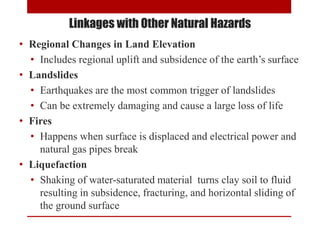Earthquakes
- 1. Earthquake - A Devastating Hazard Md Asif Hasan
- 2. Introduction Earthquakes are natural geologic events. They may be described as the vibration in the Earth produced by shock waves resulting from a sudden displacement along a fault. They can be catastrophic when the population is huge or when structures are not built to withstand an earthquake.
- 3. Most earthquakes occur on faults – areas of broken and displaced rocks. Earthquakes may develop from the movement of magma or sudden ground subsidence. Earthquakes occur in both oceanic and continental crust at varying depths. Occurrence
- 4. Development of an earthquake • Built up energy, stress and strain release on plate boundaries and faults, via deformed rock vibrating. • Initial earthquake rupture occurs on the fault at the hypocentre (also known as focus). • Movement (slip) occurs along the whole fault plane with rapid energy release in all directions.
- 5. Geographic Regions at Risk from Earthquakes • Earthquakes are not randomly distributed • There are well-defined zones along the boundaries of Earth’s tectonic plates
- 6. • Plate Boundary Earthquakes • Earthquakes occur along all three types of plate boundaries • Convergent • Divergent • Transform • The world’s greatest earthquakes that happen in the last 100 years have been along megathrust subduction zones • These are called megathrust earthquakes • Intraplate Earthquakes • Less common • Can be large and extremely damaging • They don’t happen often so people are less prepared for them
- 8. Earthquake Shaking • Three important factors determine the shaking you will experience during an earthquake • Earthquake magnitude • Your location in relation to the epicenter and direction of rupture • Local Soil and rock conditions • Generally strong shaking may be expected from earthquakes of moderate magnitude (M 5 – 5.9) or larger • These types of earthquakes will cause the ground to rock and roll damaging building and other structures
- 9. • Regional Changes in Land Elevation • Includes regional uplift and subsidence of the earth’s surface • Landslides • Earthquakes are the most common trigger of landslides • Can be extremely damaging and cause a large loss of life • Fires • Happens when surface is displaced and electrical power and natural gas pipes break • Liquefaction • Shaking of water-saturated material turns clay soil to fluid resulting in subsidence, fracturing, and horizontal sliding of the ground surface Linkages with Other Natural Hazards
- 10. Four ways the actions of people can cause earthquakes • Over -Loading the Earth’s crust with building a dam and reservoir • Injecting Liquid waste deep water into the ground through disposal wells • Creating underground nuclear explosions • Hydraulic Fracturing-exploring for oil and natural gas Human Interaction with Earthquakes
- 11. Minimizing the Earthquake Hazard Earthquakes cause lots of damage and loss of life. Consequently there has been research formed with the following goals to minimize earthquake damage • Develop and understanding of the earthquake source • Determine earthquake potential • Predict effects of earthquakes • Estimation of Seismic Risk • Perception of the Earthquake Hazard: Because there aren’t ways to predict or warn people of earthquakes there are problems with the perception of and adjustment to the earthquake. Society is vulnerable to catastrophic loss from large earthquakes due to old buildings, too big of buildings , and many other problems
- 12. Community Adjustments to the Earthquake Hazard Since we can’t avoid living in earthquake prone areas, society needs to take steps to adjust to the earthquake hazard by doing these following steps to avoid these hazards • Facilities which are critical to communities need to located in safe areas • The need to build buildings so they don’t fall down and kill people will make society safer if an earthquake should happen • Education on what and how to protect yourself during an earthquake and how to build earthquake safe, decreases the hazards of earthquakes • If you are in an earthquake prone area, take get earthquake insurance, • Make adjustments to your home to make it earthquake safe and have a plan if an earthquake happens












